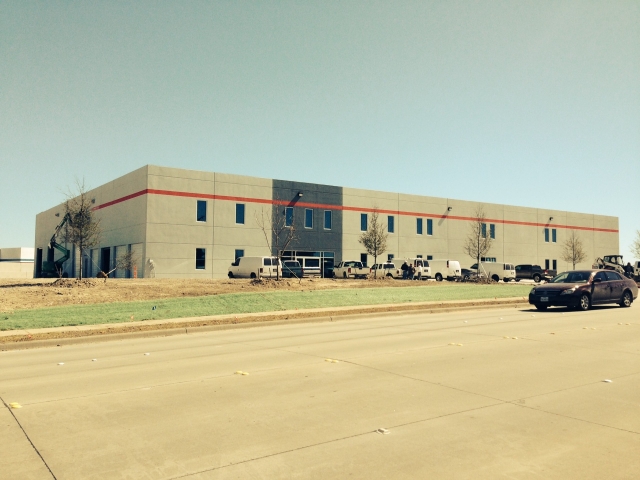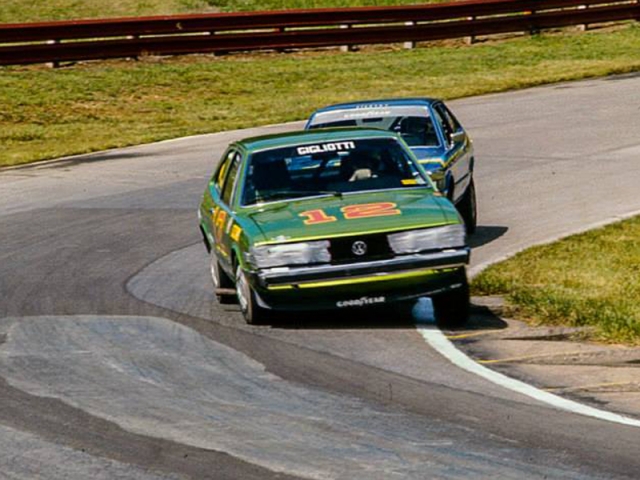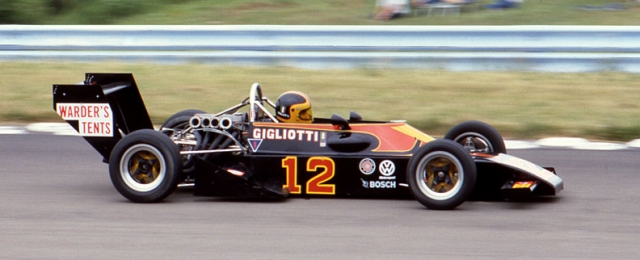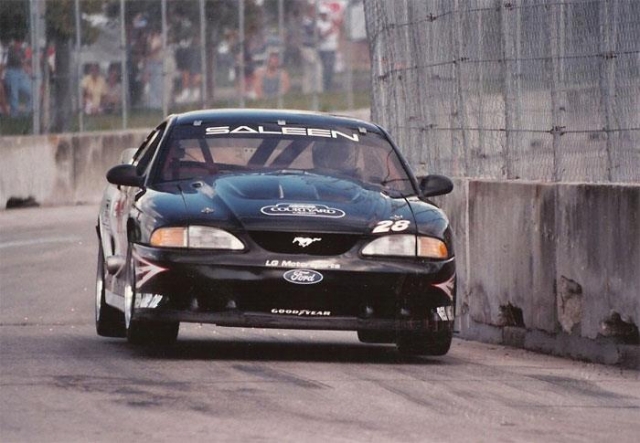It’s been said that, “If you aim for the stars and miss, you’ll land on the moon. And the moon isn’t such a bad place to be.” Who said that? Well, for one, the subject of today’s Corvette Online interview, among others. Texan, race car driver, entrepreneur, and aspiring politician, Lou Gigliotti, said it during the course of our interview, when discussing his attitude towards teaching his children how to succeed in life.
 Gigliotti, who took a $1,200 loan nearly 40 years ago to move his fledgling family from New York to Texas, has been the beneficiary of lots of hard work and being in the right place at the right time over the course of his career. That tenacity has taken his company, LG Motorsports, from those hardscrabble roots to a position where they were recently able to move into a brand-new 45,000-square foot facility where they provide the motorsports aftermarket with track-proven parts and pieces.
Gigliotti, who took a $1,200 loan nearly 40 years ago to move his fledgling family from New York to Texas, has been the beneficiary of lots of hard work and being in the right place at the right time over the course of his career. That tenacity has taken his company, LG Motorsports, from those hardscrabble roots to a position where they were recently able to move into a brand-new 45,000-square foot facility where they provide the motorsports aftermarket with track-proven parts and pieces.
Lou has a long road racing history in all sorts of cars and during our recent interview we got a chance to learn what makes him tick. Our conversation spanned all sorts of subjects: Read on to learn a bit about the man and what makes him so successful at everything he does.
Corvette Online: Racing has been such a big part of your life. How did you get your start?
Lou Gigliotti: “I started racing in a Triumph TR3. Who would race in a TR3? Just some nut. We’re talking about 1972 here. It was a typical TR3, but I took the body off, made a lot of parts for it, and even welded the roll cage into the car with a torch to strengthen the chassis. The TR3 had a solid rear axle with a pair of springs, and they were really evil-handling cars.”
“I got the bright idea after looking at a few stock cars to disassociate the springs from the axle and put a four-link with a Watts link into it. Way back then, that was pretty unheard of. I think we were the only TR3 that had that done.We made it all the way to the runoffs for the national championship with that car before a rear axle broke. The car was so good that we outqualified the factory British Leyland team.”
“A local racer, Barry Budlong, ended up offering me a sponsorship and we went up to Mossport in Canada together on Formula One weekend in 1974. I had never seen Mossport before–I was this little punk kid who had just graduated from college. I put the car we took– a Datsun 510 we had bought from another racer who never did anything with it – on the pole. We went out and won the first five races in a row. At our first Pro race, we put the car on the pole and learned that racing teaches you how to build things to last. Racing teaches you that when things break, you have to learn how to make sure they don’t break again. Over the last 40 years we’ve learned how to do that and put it into what we build now for the street.”
CO: What was the next step for you at that point after being so successful with the smaller cars?
LG: “In 1974, my sponsor decided that he really wanted to take me to the Indianapolis 500, so we got a Super Vee, which was a miniature Indy car. The first year was a real teething year, we didn’t really do much until we switched to a different design built by Citation Engineering in Indianapolis. By 1976, I put the Super Vee on the outside pole at Watkins Glen. We had a brake problem in the rear, but I still finished the race with no pedal and only lost second place with two laps to go. Five of the top six guys in that field went to Indianapolis– Herm Johnson, Gordon Smiley, Bill Alsup, Bob Lazier, and Howdy Holmes. I was the only guy out of the top six that didn’t go to Indy. Everything happens for a reason– I didn’t make it to Indy, but that’s probably why I’m not walking with a limp and still have my head screwed on straight.”
CO: What were you doing at the time that permitted you to race?
LG: “My sponsor had pulled out– he had spent all the money he could afford. I went to the manufacturer to figure out how I could get another Super Vee car, and that’s when I built my very first racecar from scratch. I went to Indianapolis, slept in the barn for 30 days at his shop, worked for them for free during the day, and at night I was able to build all my own race parts for free.”
“I left there with all the parts I needed to build my racecar, went back to my shop, built the jigs, my own monocoque tub, and my own Super Vee. We were faster than the factory cars, but we had no money. I sold the car and tried again the next year, but it got to the point where we just had no money to compete– an engine was $10,000, and I was a teacher making $8,000 per year. An engine was a year’s salary.”
CO: A teacher? Tell us about that.
LG: “In 1979 I quit racing and said I couldn’t do it anymore. I had gone to college to get a degree in mathematics and become a teacher, and at this time I went to work for Volvo. With my teaching degree I was able to teach their technicians and get them all their ASE certifications. During my travels they kept sending me to Texas, which was their mistake, because I fell in love with the state. In 1982, after I got married, one of my former competitors called me and asked me to race Summit Point– I hadn’t raced in a few years, and I finished top three in each race we ran. We moved to Texas in 1983 and my son Louis was born. I couldn’t forsake my family to go racing, so I drove for other people.”
Left - Lou Gigliotti leads Buck, Hayner, Lockhart and Pilgrim at Mosport 1989 Corvette Challenge. Right - Lou's Camaro World Challenge GTS car, photo copyright Jerry Winkie.
CO: Where did racing Corvettes come into the picture?
LG: “In 1988, the Corvette Challenge came out and it seemed like the perfect thing. It was a special Corvette built by Chevrolet and the engines were sealed and supposed to be all equal. I managed to convince a Corvette dealer to set me up with a car, truck, and trailer– but I needed a shop to work out of, and that’s when LG Motorsports was born. I ran the shop during the week, and then I’d take off to go racing. The class was really competitive– there were ten or twelve guys that were thousandths of a second apart. I made my way hauling cars around for a couple of the other drivers and they paid us to haul them around, so I made my way doing that.”
CO: What about your successes in the SCCA’s World Challenge series?
LG: “Our history there starts around 1990, when the Corvette Challenge became the World Challenge. I had a sponsor put up a brand-new Corvette, and all the while I had a couple of guys here at LG Motorsports keeping the company going and working on Corvettes– that put me on the map because we were consistently fast. I hooked up with a lawyer from San Antonio who asked me to drive his car at Watkins Glen. The car had never been in the top 20 and I qualified third with it after putting some work into it. We won the national championship there three times. In World Challenge, I ran about 110 races with 26 pole positions and 23 wins, which is a 20 percent win ratio. We also ran the Trans Am series, won the Long Beach Grand Prix and Trans Am events along with Lime Rock’s Grand Prix, and Trans Am races.”

LG Motorsports’ new 45,000-square-foot facility in Plano, Texas. A pair of Dynojet dynamometers are on site – a two-wheel unit and a four-wheel-drive eddy current piece – and there is a 9,000-square-foot second floor warehouse.
CO: So you raced Corvettes in the beginning– how did you get into the Camaro market?
LG: “In 1993 the 4th Gen Camaro came out and we wanted to have a little bit of an advantage so we had a friend of ours in Detroit design a body kit for the car. That was one of the first products we really made. We needed them for the racecar and figured we could sell them– people wanted to buy the fancy swaybars that we made. I’d be in the back of the shop welding all this stuff up and we started hiring people. It just grew and grew and grew.”
CO: What about the Mustang? We know you’ve done some racing with Steve Saleen.
I’m happy to be where I am, and to have accomplished what I have accomplished. – Lou Gigliotti, LG Motorsports
“Since we didn’t have anything for the Ford in the shop we had to get a couple of things done to make the cars legal. We went to this meeting with SCCA about some rules and Steve shows up– he didn’t want anyone to run a Ford without his involvement. It turned out to be one of our most profitable years. Ford set us up with cars and a parts budget, which we had never had before. I built three cars, rented out two, and ran the other one. We won the championship in 1996 and 1997 with Saleen’s involvement.”
“Steve set us up with some money for winning the championship but I put a clause in the contract where if I could win the championship, I’d be able to cut Steve’s hair – he had a mullet – on the podium at the awards banquet. On the podium, Steve gave the award to me and I reminded him about the hair cutting. I reached in my pocket, pulled out a pair of shears, grabbed his hair, slid the scissors all the way up, and chopped it off.”
CO: How have you grown LG Motorsports?
LG: “I took a loan from Beneficial Finance to make my way to Texas in the beginning. I had the little car repair shop and we were working on Corvettes– I thought that was a pretty good way to be. I managed to swing a deal to have a car to drive in the 1989 season, with the contingency that if I won enough prize money, I’d get to keep the car, and if I didn’t, I would pay the difference or give the car back. At the end of that year, I won enough prize money to not only keep the car and get the title, I also got a check for $20,000. So I took the car to an auction in Florida and sold it for $30,000, and all of a sudden I had $50,000 to invest in my hand-to-mouth little company. One of my teammates when I raced with Saleen was Simon Gregg. Simon decided that he wanted to move up and race Trans-Am.”
“He paid me to build him a car, and I left myself enough money to build the car and took half the deposit, bought some land, and built our first headquarters, a 15,000 square-foot building in Wylie, Texas. It served us well for 12 years and I recently sold it and made a ton of money on it because the town grew in size substantially. The road went from two lanes to six lanes and I took the money from that to build our new headquarters, which is in Plano, Texas– 45,000 square-feet and over an acre under one roof. Don’t forget, I borrowed $1,200 to get here. In my world, nothing is impossible, because I started with nothing.”
 CO: How do you go from making parts for the Camaro market to the Corvette market? Those are very different types of enthusiasts.
CO: How do you go from making parts for the Camaro market to the Corvette market? Those are very different types of enthusiasts.
LG: “When GM decided to cancel the Camaro, all of our parts base and everything we sold was based on the Camaro. So in 2000, we bought a Corvette and started making a lot of parts for those. We took the 5.7L engine and turned it into a 418. The headers we bought were not race quality, and we knew they were killing the horsepower. My son Louis and I built our first set of race-quality headers using the merge collectors from our racecar and we picked up 23 horsepower and 27 foot-pounds of torque over the other headers– and then we started getting orders.”
“We were charging almost $3,000 per set since they were all built by hand. In 18 months we built 70 sets. Every set was different since we didn’t have a real jig– just an engine, chassis, and transmission out in the shop. Finally, we got a call from Borla, who offered to build our headers for us. They made a set, sent them back, and I tried to order 50 sets. They needed me to order 500 at one time, but I didn’t know if the market was there for that.”
“I managed to swing a deal where they would send me 50 sets a month and if we couldn’t sell the whole 500, they’d own the design. I made the decision that we were taking 500 no matter what– I had my wife opening every credit card application we got. We started advertising on the internet, which was just coming into its own, and the day Borla sent me the first 50, we were already backordered by 15 sets and I was constantly on the phone to Borla looking for more. We sold about 600 sets that year.”
CO: Switching gears, we hear you’ve run to be a congressman.
LG: “We have an incumbent here that’s virtually unbeatable– he’s been in office for 34 years now and he’s 90 years old. Great guy, but his time’s up. I sold a car, put $100,000 into my campaign, and finished a solid third place– the second guy was a Chicago-born lawyer that put a million dollars into his campaign. None of us got 50 percent of the vote which means there’s a runoff between the top two guys and that election is May 27th.”
“I endorsed the incumbent conservative Congressman – yes, he’s been there too long – but the other guy doesn’t have our Texas values. I’m a gun guy and hardcore conservative and shoot easily every week. Precision race cars, precision parts, precision shooting. I’m a stubborn guy and I love my freedom– I just wish we had less government. It’s time to get government back to where it’s intended– smaller, limited, and give the power back to the states.”
CO: Reflecting on your life and career so far, how do you feel?
LG: “It’s worth more than anything to me to follow my dream. Would I do anything different? No. Would it have been easier if I had money? Yes. Would it have been any more satisfying? No. I’m happy to be where I am and to have accomplished what I have accomplished.”
During our conversation with Lou, we discussed forty years of racing history, much of which didn’t fit into the space we have allotted for our article. We tried to cover the salient points of his racing accomplishments and toss in some of the funny anecdotes he shared with us. It was our distinct pleasure to have an opportunity to get to know the man inside the helmet.






























